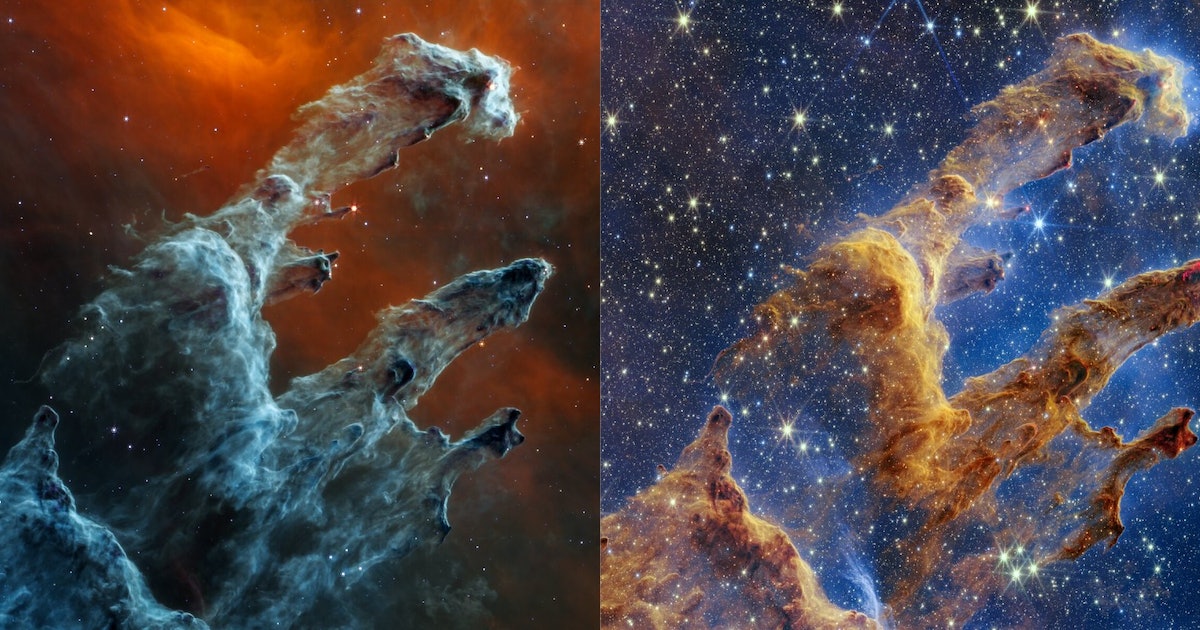
27 years ago, Hubble took one of the most iconic space images ever
Our night sky is a canvas awash with spectacular viewing opportunities. If somehow humanity curated its celestial artwork into a museum exhibit, you’d probably find the Pillars of Creation on the brochure cover. What is so extraordinary about this scene, located 6,500 light-years away in a pocket of the Milky Way that’s also full of supernovas, solar flares, and planetary rings?
The Pillars of Creation was an image special enough to be featured on a U.S. postage stamp to commemorate the Hubble Space Telescope and its namesake, astrophysicist Rogier Windhorst tells Inverse.
Here is a guide to the stunning Pillars of Creation and why one space telescope veteran stands by the scene’s remarkability.
Windhorst has been an interdisciplinary scientist for the James Webb Space Telescope (JWST) since 2002. The Pillars of Creation were first observed from the ground, he says, but JWST’s predecessor, Hubble, catapulted the region to fame when it imaged this pocket of the much-larger Eagle Nebula back in 1995. And JWST viewed the region last month, providing two incredible new views of its celestial spires.
There’s a reason this view has lingered in the popular imagination for almost three decades.
“Because the contrast is so high,” Windhorst says. There is “a day and night difference between where the stars are and where the gas and the dust is.”
On October 19, the JWST team published its first view of this region. Described as a “kaleidoscope of color,” the image shows where some gas has evaporated (blue) and where some are “still cocooning, literally speaking, around stars that are forming.”
It’s a tale of star birth that gets further in-depth depending on the wavelength of light the telescope collects. The glittering image was published on October 19 and comes from JWST’s Near-Infrared Camera (NIRCam). Another view published two weeks later, made from observations of another of the telescope’s next-generation eyes, the Mid-Infrared Instrument (MIRI), is just as spectacular, if not more possessing.
“I think the public was and will get excited about the image [from MIRI] because there you see the dust and the gas alone in its full glory, without the stars, except the ones that are just forming at the ends of the pinnacles, the orange ones,” Windhorst says of the MIRI image shared to the public on Friday (October 28).
The grayish-blue columns of dust and gas, which are “many light-years across,” stand out in absence of the stars, whose sparkle doesn’t appear in mid-infrared. And here, in the quiet of this wavelength, the viewer can see the birth of Sun-like stars.
“The gas and the dust is very, very prevalent,” Windhorst says, “and if you now go to the top of these pillars, the largest one on the top, for instance, you can see that there is a star forming there at the end of the gaseous pillar.”
There are at least two generations of stars in the Pillars of Creation. The oldest ones are the ones that decorate the NIRCam image, large and brilliant, with enough radiation to sweep the leftover dust into the now-famous shapes of the Pillars of Creation. And within these structures, a new generation of smaller stars take shape and begin to shine.
No doubt, the Pillars of Creation are ready to inspire a new generation to fall in love with the cosmos.
Our night sky is a canvas awash with spectacular viewing opportunities. If somehow humanity curated its celestial artwork into a museum exhibit, you’d probably find the Pillars of Creation on the brochure cover. What is so extraordinary about this scene, located 6,500 light-years away in a pocket of the Milky Way that’s also full of…
Our night sky is a canvas awash with spectacular viewing opportunities. If somehow humanity curated its celestial artwork into a museum exhibit, you’d probably find the Pillars of Creation on the brochure cover. What is so extraordinary about this scene, located 6,500 light-years away in a pocket of the Milky Way that’s also full of…